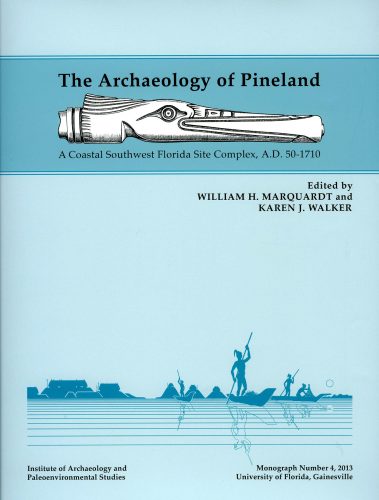A major new book about Pineland is now available. The Archaeology of Pineland: A Coastal Southwest Florida Site Complex, A.D. 50-1710 was edited by William Marquardt and Karen Walker. It contains 943 pages, 408 figures, 231 tables, bibliographic references, and an index.
 In the 1500s, the Calusa Indians controlled all of southern Florida. Their archaeological sites dot Florida’s southwest Gulf coast, yet little has been known about the people who lived on them until recently. Until the work at the Pineland Site Complex, there was no extensive study of any of their principal towns, nor of the abundant but dynamic environment that sustained them. The Archaeology of Pineland fills this gap by reporting and synthesizing the results of a multiyear, interdisciplinary, historicalecological project.
In the 1500s, the Calusa Indians controlled all of southern Florida. Their archaeological sites dot Florida’s southwest Gulf coast, yet little has been known about the people who lived on them until recently. Until the work at the Pineland Site Complex, there was no extensive study of any of their principal towns, nor of the abundant but dynamic environment that sustained them. The Archaeology of Pineland fills this gap by reporting and synthesizing the results of a multiyear, interdisciplinary, historicalecological project.
Not only did the Pineland Site Complex encompass more than 100 acres, but it was the beginning point of the remark able Pine Island Canal. Although focused mainly on 1700 years of Native American occupation, the book also provides new information about postcontact changes in culture and landscape, bringing the story of Pineland up to the present day.
A team of 18 authors introduces and situates Pineland geographically, historically, and environmentally, then reports new information and interpretations based on systematic auger surveys, archaeological soils analyses, paleoethno botany, zooarchaeology, site seasonality, and human osteology. A chapter is devoted to the Spanish period at Pineland, as well. Also included are detailed studies of artifacts found at Pineland—ceramic, stone, shell, bone, tooth, wood, and fiber—that will be valued by all those interested in Florida archaeology. The final chapter synthesizes the cultural and environmental changes that led to the sixteenthcentury Calusa kingdom and documents 300 years of developments since the Calusa abandoned their impressive town.
The Archaeology of Pineland contains neverbefore published information about the archaeology, history, and environment of Southwest Florida, and will be an essential reference work for future studies. It also stands as a detailed and tangible case study of the approach known as historical ecology. The book will be available at our book shop at the Calusa Heritage Trail or from the University Press of Florida.
This article was taken from the Friends of the Randell Research Center Newsletter Vol 12, No. 1. March 2013.